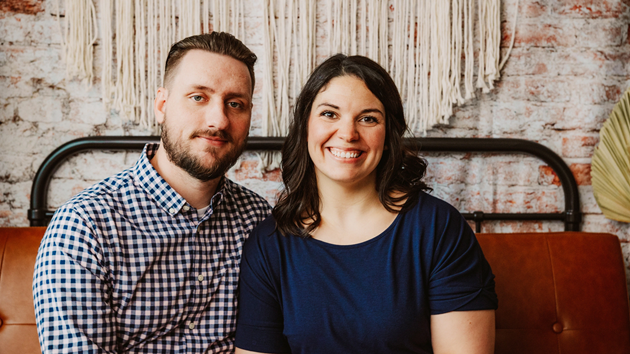(NEW YORK) — Kelsey Hatcher, a 32-year-old mom of three, and her husband Caleb said they were very surprised to learn earlier this year that Kelsey was pregnant.
The couple was even more surprised to learn at Kelsey Hatcher’s eight-week ultrasound appointment that she was expecting two babies.
Hatcher and her husband described themselves as completely shocked to learn that the babies are each in their own uterus, a result of Hatcher being born with a rare condition known as uterine didelphys, or double uterus, meaning she was born with two uteruses and two cervixes.
While uterine didelphys is rare on its own, the odds of being pregnant at the same time in each uterus are about “1 in a million,” according to Dr. Richard Davis, a maternal and fetal medicine specialist at the University of Alabama at Birmingham’s Women & Infants Center, where Hatcher is being treated.
“When I first found out, I was like, ‘I wonder if there’s anybody I can reach out to just to, you know, see what their experiences were,"” Hatcher told “Good Morning America.” “But I think I’ve only read of two other cases [in which] they’ve had [pregnancies] in completely separate uteruses, and no one that I’ve been able to reach out to.”
Hatcher said she learned she had a double uterus at age 17, but with each of her three previous pregnancies, she had a single baby carried in one uterus. She said each of her pregnancies with her kids — now ages 7, 4, and 23 months — also went full-term, with no complications.
Knowing there was still a chance she could be carrying twins with this fourth pregnancy, Hatcher said that was one of the first questions she asked at her eight-week ultrasound appointment.
“I said, ‘There’s only one right?,’ and the [nurse] said, ‘Yeah, there’s only one,"” she recalled. “So, I just kind of laid back and was relaxing. Everything looked good. There was only one.”
Hatcher said that as she was telling the nurse to not be alarmed if she saw a second uterus on the ultrasound, both she and the nurse saw a second baby on the scan.
“Before she could say anything, I said, ‘Oh my gosh, there’s another one,"” Hatcher said, adding of her reaction, “Probably all I did was laugh for 30 minutes or so because it was just like, this is not happening.”
Caleb, Hatcher’s husband, said when his wife called to tell him they were expecting two more babies, his reaction was, “I don’t know what happened differently this time, but it’s wild.”
According to both Davis and Dr. Shweta Petal, the OB-GYN caring for Hatcher, the two babies are considered fraternal twins.
“There are lots of different types of twin pregnancies out there,” Petal told “GMA,” adding of Hatcher’s specific case, “Most likely what happened is that she ovulated separately and had one egg come down each fallopian tube, meaning coming down on each side of the uterus, and then sperm traveled up on each separate uterus and fertilization occurred separately.”
Petal and Davis are both part of a team at UAB that has spent the last several months planning for Hatcher’s delivery. Neither of the doctors, nor anyone else at the university’s medical center, has ever cared for a patient carrying two pregnancies in two uteruses.
“There’s no true expert out there who knows how to manage a patient with two uteruses and two babies, with one in each uterus,” Petal said. “So we really are relying on our baseline teaching and our baseline knowledge and the normal physiology of pregnancy that we understand, and applying it in her scenario.”
Hatcher is currently around 34 weeks pregnant and her due date is Dec. 25 — Christmas Day.
Davis said the plan is to allow Hatcher to carry her pregnancy as long as both she and the babies are healthy.
She could deliver each baby individually in two vaginal births, which could happen over the span of a few minutes or a few days, or if there are complications, Davis said they could deliver the babies via cesarean section.
“Each uterus can contract on its own at different times,” Davis said. “It could be that one side contracts, and the other side is not doing anything.
Petal noted there are a “lot of different scenarios” for which the medical team is working with Hatcher to prepare ahead of her delivery.
“They could be born minutes apart, or they can be born days apart,” Petal said. “It’s so unpredictable, and that’s why we’ve had a lot of conversations with Kelsey kind of talking about the different scenarios that could happen, where she could have a vaginal delivery with both babies, she could have a vaginal delivery with one and a C-section with the other, or maybe end up having a C-section for both of them as well.”
Hatcher said that despite the rarity of her pregnancy, it has been a smooth one so far, with just more fatigue in the first trimester than she had experienced in her previous pregnancies.
“Past the first trimester, a lot of things have been very similar, other than just feeling the movement of two,” she said, adding that in the last two weeks she has been able to see the two pregnancies separate when she lays down. “There’s like a divet in between my stomach so that you can see that each uterus has one on each side. It is pretty wild.”
Copyright © 2023, ABC Audio. All rights reserved.












